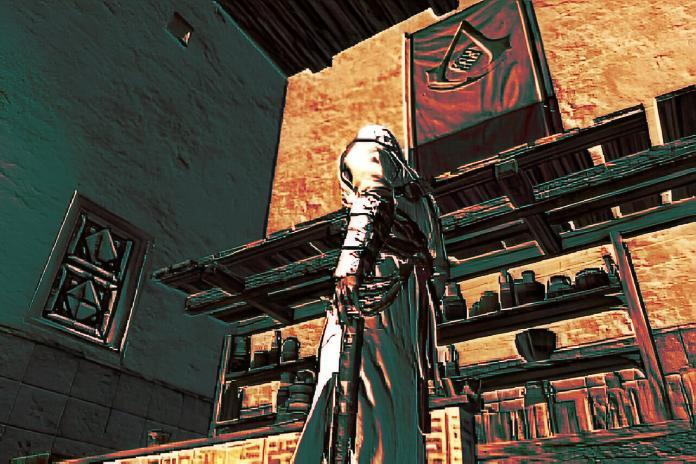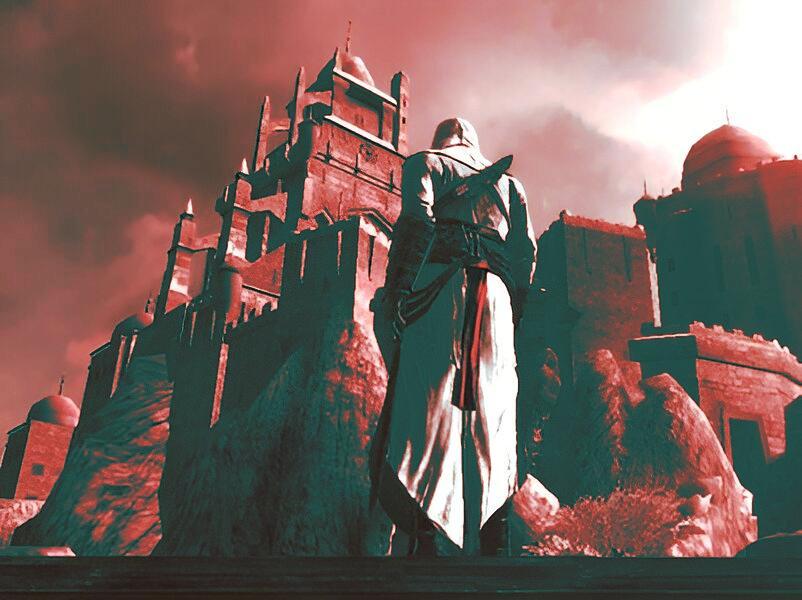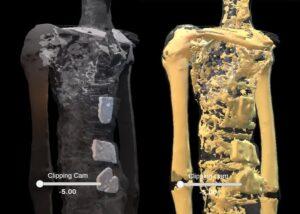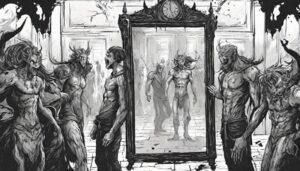The Holy Killers Of Islam And Christianity : The Latter Dark Days of The Assassins
Cast no seed upon gold…
Authored by Arkon Daraul via History of Secret Societies

In the annals of history, an indomitable ruler emerged at the helm of one of the most formidable organizations ever to grace the world’s stage. Fate, however, intervened in a peculiar manner, leaving this leader bereft of a direct lineal successor. Unconventional as ever, he had made the difficult choice to extinguish the lives of both his sons, each for their own transgressions. One met his demise for perpetrating an unauthorized act of murder, while the other suffered a tragic fate due to his indulgence in the forbidden nectar of wine. Truly, a striking case of “do as I say, not as I do.”
Determined to secure the future of his influential organization, the ruler summoned his two most trusted lieutenants from their formidable strongholds, which they diligently maintained on his behalf. The first among them, known as Kia Buzurg-Umid or Kia of Great Promise, was appointed as the rightful inheritor of the spiritual and mystical aspect of the Order. Endowed with an unparalleled understanding of the esoteric and metaphysical realms, Kia was destined to carry forward the mantle of spiritual enlightenment, illuminating the path for all who would follow.
Aligned with the ruler’s vision, the second lieutenant, Abu-Ali of Qaswin, assumed the mantle of responsibility over the military and administrative affairs of the Order. Gifted with a strategic acumen and an unwavering dedication to the cause, Abu-Ali became the stalwart guardian of the organization’s practical operations, ensuring its seamless functioning and continued prosperity.
Thus, united by their unwavering loyalty and complementary skills, Kia and Abu-Ali forged an unbreakable alliance. Together, they steered the terrifying organization through uncharted waters, upholding the ruler’s legacy in extraordinary ways. While Kia delved into the depths of spiritual wisdom, guiding the members towards enlightenment and inner growth, Abu-Ali presided over the military might and administrative intricacies that fortified the organization’s dominance.
In this extraordinary tale of succession, the ruler’s lack of a direct lineal heir did not deter the relentless pursuit of his grand vision. Through the symbiotic collaboration of Kia and Abu-Ali, the organization transcended the boundaries of conventional inheritance, defying expectations and thriving under their joint stewardship. Their indomitable spirit and unwavering dedication ensured the legacy of the most fearsome organization the world has ever known remained unyielding, casting an enduring shadow over history.
Following his momentous contributions to the world, Hasan bin Sabah, the enigmatic leader, met his demise shortly thereafter in 1124 at the remarkable age of ninety. It was during his eventful lifetime that he bestowed upon humanity a word that would etch itself into the annals of history: “assassin.” Derived from the Arabic term “Assasseen,” meaning “guardians,” this word has sparked much debate among scholars. Some contend that its true origin lies in the phrase “guardians of the secrets,” a testament to the clandestine nature of the organization under Hasan’s tutelage.
The Order, under Hasan’s astute leadership, comprised three distinct groups: Missionaries (Dayes), Friends (Rafiq), and Fidavis. The Missionaries were the emissaries of the Order, spreading its teachings far and wide. The Friends, on the other hand, were devoted disciples who wholeheartedly embraced the Order’s principles. The final group, known as Fidavis, were an addition made by Hasan to the original Ismaili framework. These individuals were rigorously trained in the art of assassination, their skills honed to perfection.
Dressed in white attire, adorned with a crimson girdle, cap, or boots, the Fidavis embodied both stealth and purpose. Their training extended beyond the mere mastery of lethal techniques. They were well-versed in various languages and adept at assimilating the mannerisms and appearances of monks, merchants, and soldiers. This comprehensive preparation allowed them to seamlessly assume different identities, executing their missions with precision and discretion.
At the helm of this formidable organization stood the chief, known as Sayedna, meaning “Our Prince” or “Leader.” Due to the Order’s mountain stronghold, Alamut, the chief was also popularly referred to as the Sheikh of the Mountain. In the chronicles of the Crusaders, this figure appears under the names “Sydney” or “Senex de Monte,” with the former being a direct translation of the Persian term “Pir,” signifying “Ancient” or “Sage.”
The Order’s vast territories were governed by three eminent Missionaries, each holding sway over a distinct region. Following the Missionaries, the Order enlisted the Laziks, aspirants who were undergoing training with the aim of joining the esteemed ranks of the society. Though not yet initiated, these individuals ardently pursued knowledge and eagerly awaited their induction into the Order’s inner circle.
Cast No Seeds Upon Rocks

Hasan bin Sabah, the enigmatic leader of the Order, made a significant alteration to the initiation process. He reduced the original number of degrees from nine to the mystical number of seven. This change had a profound impact on the structure of the Order and the progression of its members.
Regulations and Rules of the Order
In addition to the reduction in initiation degrees, a similar number of regulations were established to govern the operations of the Order. These rules formed the foundation of the Order’s functioning and were integral to the spread of its faith.
The First Rule: Understanding Human Psychology
One of the fundamental rules of procedure was that the Missionaries, responsible for recruiting new members, needed to possess a deep understanding of human psychology. This knowledge enabled them to identify suitable individuals for admission into the cult. The essence of this rule was encapsulated in a mnemonic: “Cast no seeds upon rocks.” It emphasized the importance of selecting receptive individuals who would be open to the teachings of the Order.
The Second Rule: Flattery and Gaining Confidence
The second rule focused on the application of flattery and gaining the confidence of prospective members. Missionaries were instructed to employ tactics that would create a sense of trust and admiration in the minds of those they sought to recruit. By establishing a rapport and building a positive relationship, the Missionaries aimed to facilitate the process of initiation.
The Third Rule: Casting Doubt through Superior Knowledge
To further solidify the prospective member’s commitment, the third rule involved the casting of doubt into their minds through the display of superior knowledge. Missionaries were trained to showcase their expertise and proficiency in the teachings of the Order, thereby instilling a sense of curiosity and intrigue in the aspirants.
The Fourth Rule: The Oath of Secrecy
The fourth rule required the teacher to administer an oath to the student, binding them to an unbreakable promise of never betraying any of the “truths” that would be revealed to them. This oath served as a crucial safeguard to protect the secrets and doctrines of the Order.
The Fifth Stage: Revealing the Power and Support
In the fifth stage of the initiation process, the aspirant was informed that Ismailism was a potent secret organization, backed by influential figures of the time. This revelation aimed to create a sense of prestige and significance around the Order, reinforcing its allure and appeal.
Assessing the Aspirant’s Absorption and Dependence
After the revelation of the Order’s power and support, the aspirant underwent a period of questioning and assessment. The teacher carefully examined whether the aspirant had internalized the teacher’s opinions and ideas, and if they had formed a sufficient level of dependence on them. This evaluation was crucial in determining the aspirant’s readiness for full membership within the Order.
These rules and stages of the initiation process were meticulously designed to ensure the selection of committed and dedicated members who would uphold the teachings and objectives of the Order.
Paradise lies in the Shadow of Pawns

The detailed knowledge of the rules and practices of the Order can be attributed to historical events that unfolded after the Mongols overthrew Alamut, the stronghold of the Assassins. Following their victory, Halaku Khan, the Mongol leader, tasked his chief minister, ‘Father of Kings’ Jawani, with examining the library of the Assassins. Jawani, a highly learned man, meticulously documented the organization and workings of the Order in a book.
Halaku Khan’s Examination of the Library
After the Mongols successfully overthrew Alamut through military force, Halaku Khan, the leader of the Mongols, showed a keen interest in understanding the secrets and workings of the Assassins. He instructed his chief minister, ‘Father of Kings’ Jawani, to carefully examine the library of the Assassins.
Jawani’s Detailed Account
Jawani, being a highly knowledgeable and learned individual, took on the task of studying and documenting the organization of the Assassins. He wrote a comprehensive book that provided intricate details about the Order, including its rules, practices, and methods of recruitment.
The Use of Hashish and Allegorical Interpretations
In his book, Jawani attributed the name of the Assassins to their alleged use of the drug hashish, which was said to be employed to stupefy candidates during their temporary visit to ‘paradise.’ This explanation, though widely known and popular, should be approached with caution, as it may be a later embellishment or misinterpretation.
Furthermore, Jawani’s account revealed that in the final degree of initiation, many difficult passages of the Quran were explained in terms of allegory. This suggests that the Assassins employed symbolic interpretations to convey their teachings and beliefs.
Recruitment Methods

Regarding the recruitment methods of the Assassins, the historical records do not provide explicit details. It is speculated that the Order may have employed various strategies, potentially beyond simply selecting gullible, fully grown youths. However, without further historical evidence, it remains uncertain how exactly recruits were chosen and initiated into the Order.
The information about the Order’s rules and practices, as detailed by Jawani, provides valuable insights into the functioning of this secretive and successful organization.
The legend surrounding Hasan, the master of Alamut, suggests that he would purchase unwanted children from their parents and train them to be fiercely obedient, with the sole desire to die in his service
. This practice ensured that the Assassins were loyal and dedicated to their cause. This pattern of recruitment and training continued under Buzurg-Umid, the second Grand Master, who maintained the power of the Assassins by building new forts, gaining new converts, and using fear to control those he did not wish to eliminate. Despite several unsuccessful expeditions against Alamut, Sultan Sanjar of Persia was unable to effectively challenge the Assassins’ authority. Ambassadors from both sides were killed, and a prominent religious leader was captured, given a mock trial, and thrown into a furnace.
During this time, the Grand Master typically deployed no more than two thousand men at a time. However, it is important to note that these individuals were highly trained killers who operated under strict discipline. They proved to be formidable opponents, capable of outmatching and defeating organized armies.
The power and influence of the Assassins were sustained through their strict hierarchy, well-organized fortresses, and the unwavering loyalty of their members.
Wadi El Jan

The Order of Assassins began to expand its influence in Syria, establishing continued contact with the Crusaders who were in control of a significant area extending from the Egyptian border to Armenia in the north
. Bahram, a Persian leader of the Assassin cult from Astrabad, gained control of a powerful fortress in Syria, specifically in the region known as the Valley of Demons (Wadi-el-Jan). From there, the Assassins spread their influence by capturing and fortifying additional strongholds.
Under the leadership of Bahram’s successor, Ismail the Lash-Bearer, the Assassins executed a clever plan. They planted a trained devotee within the ranks of the saintly Vizier of Baghdad, gradually earning his trust and working their way up to the point where this Assassin, now known as the ‘Father of Trust’, was appointed as the Grand Judge of Baghdad. This strategic move allowed the Assassins to exert their influence and control over key positions of power in the region.
Nature of Men

The Crusaders had been in the Holy Land for about thirty years when the Assassins decided that forming an alliance with them against Baghdad would be beneficial. A secret treaty was made between the Grand Master of the Assassins and Baldwin II, the King of Jerusalem. According to the treaty, the Ismaili Grand Judge would betray Baghdad by opening its gates to the Crusaders if the fortified city of Tyre was handed over to the Assassins.
However, something went wrong. The Grand Judge had ordered one of his subordinates to open the gates of the city. This information reached the military commander of Damascus, who wasted no time in killing the subordinate, the Vizier, and around six thousand people suspected to be secret Assassins within the city. The Damascus garrison then launched an attack on the Crusaders and successfully pushed them back during a thunderstorm. The Christian warriors attributed the storm to divine anger towards their unworthy alliance, while the Assassins saw it as an attempt by the forces of nature to expose the Crusaders as they entered the city under its cover.
Beyond Mosul

During the rule of the Second Grand Master of the Assassins, there was a continued pattern of assassinations against rulers who opposed the Assassin creed. One example of such an assassination occurred when the renowned Aksunkur, Prince of Mosul, returned from Ma’ara Masrin. As he entered the Mosque at Mosul to pray, he was attacked by eight Assassins disguised as dervishes. Despite the valiant efforts of the Prince, who managed to kill three of the Assassins, he was fatally wounded and died before his people could come to his aid.
After the death of the Second Grand Master, his son Kia Mohammed was appointed as his successor. Under Kia Mohammed’s leadership, the assassinations continued, and the Assassins gained control of a part of the Palestinian coastline. The leaders of the cult publicly reaffirmed their adherence to orthodox Islam, while the secret doctrine of the divine leader was kept hidden from the uninitiated. However, it became apparent that Kia Mohammed’s own son, Hasan the Hated, possessed a stronger personality and captivated the Assassins with his magnetic power.
Hasan convinced his followers that he was the Hidden Imam, the Power of All Powers mentioned by the first Grand Master. He asserted that all authority stemmed from him, and others held their positions only because he allowed it. Despite his readiness to assume the role of the Hidden Imam, Hasan held back due to his father’s ability to assert himself by having hundreds of his followers murdered.
In 1163, after Kia Mohammed’s death, Hasan II called upon all Ismailis to gather beneath the castle of Alamut. This assembly consisted of killers, fanatics, and those who had been conditioned to believe in extraordinary claims. Hasan, possibly in a state of megalomania, proclaimed that he had received a message from the Almighty, declaring that all religious bonds were now loosened and everyone was free to act as they pleased. He declared himself the Hidden Imam, with his word being law and his authority derived from divinity.
To overcome the obstacle of not being a descendant of the Prophet Mohammed’s Family of Hashim, as required by Ismaili doctrine, Hasan II claimed to be an adopted child of the Caliphate family of Egypt. This charade lasted for four years, during which Hasan consolidated the power of the cult efficiently. However, he was eventually assassinated by his brother-in-law, Namwar (also known as “The Famous”).
The succession continued with Mohammed II, son of Hasan II, who emphasized the cultivation of literature and sciences. Mohammed II used the Assassins to assert his superiority as a poet and philosopher. When the prominent theologian Imam Razi refused to acknowledge the Assassins as the most advanced theologians, Mohammed II sent an envoy who offered the Imam a choice between swift death by dagger or a substantial annual pension. The Imam, fearing for his life, began to speak less forcefully against the Assassins. When asked why he no longer challenged them, the Imam nervously acknowledged their sharp and pointed arguments, alluding to the potential danger of openly opposing them.
These events illustrate the power dynamics and ideological complexities within the Assassin cult during this period.
Menace

In the realm of the Ismailis, a powerful figure named Mohammed II reigned with an unwavering authority for a remarkable span of thirty-five years. Under his iron rule, obedience to the Assassin will became the sole law of the land, superseding all other codes and regulations. The traditional observances of ritual Islam were abolished, marking a significant departure from the established norms of the time.
However, amidst this era of change and uncertainty, a new star began to rise. His name was Saladin, a formidable figure who would later become an implacable foe of the Assassins. Saladin possessed a unique power, one that would strengthen the resistance against the Crusaders who sought to penetrate their territories.
As Saladin’s influence grew, he became a beacon of hope for those who opposed the Assassin regime. His charisma, strategic brilliance, and unwavering determination inspired many to rally behind him, seeking to challenge the oppressive rule of Mohammed II and his followers.
The clash between Saladin and the Assassins would become an epic struggle, defining the course of history in the region. Both sides displayed unwavering resolve, employing every resource at their disposal to gain the upper hand. The conflict was not merely a battle of arms, but also a war of ideologies, as the traditional Islamic practices clashed with the unyielding rule of the Assassins.
In the face of this formidable opposition, Saladin’s determination remained unshaken. He sought to unite the fragmented forces against the Assassins, forging alliances and rallying support from various factions. His ultimate goal was to reclaim the lands that had been lost to the Crusaders, while simultaneously dismantling the oppressive regime of the Assassins.
The outcome of this clash of titans remained uncertain, as both Saladin and the Assassins were driven by an unyielding resolve. The fate of the Ismailis, as well as the destiny of the entire region, hung in the balance. The stage was set for a monumental struggle, one that would be remembered for generations to come.
During this period, the Syrian branch of the cult, known as the Assassins, experienced a significant rise in power. They operated more openly and assertively compared to the Eastern Assassins, who preferred to carry out their activities quietly. The Eastern Assassins, however, sought to spread their influence by sending missionaries to various regions, including India, Afghanistan, and even the remote Pamir mountains, which span across China and Russia. It is worth noting that even today, followers of the sect can still be found in these areas.

Saladin’s Triumph over the Ismaili Branch in Egypt
Saladin, a prominent figure during this time, managed to overcome the Ismaili branch of the cult in Egypt and restored what he believed to be the true faith among the people of the Nile. His military victories provided him with substantial resources, enough to sustain a ten-year war against the Crusaders in Palestine. Saladin also had surplus troops at his disposal. With his newfound power and influence, his primary objective became the unification of the forces of Islam, which he was determined to achieve by force if necessary.
Opposition from Sinan, Ancient of the Assassin Cult
Sinan, an influential figure within the Assassin cult in Syria, decided to oppose Saladin, whom he considered a formidable enemy of the Fatimites. In an attempt to eliminate Saladin, three assassins made an assassination attempt on his life. This incident made the Assassin sect a priority target for Saladin.
In response, the Old Man of the Mountain, another name for the leader of the Assassin cult, unleashed a series of fanatics in various disguises to target Saladin. These fanatics were relentless in their pursuit and posed a constant threat to Saladin’s life.
Saladin’s Actions against the Cult
By 1176, Saladin reached a critical decision and concluded that the cult had to be dealt with decisively. He invaded their territory and began to devastate it as a means to weaken their power. However, the Assassin chief offered Saladin a proposition: freedom to fight the Crusaders without further attempts on his life if the cult was spared. Saladin, recognizing the value of this offer, agreed to the terms.
Henceforth, no Assassin ever attempted to harm Sultan Saladin again. This agreement allowed Saladin to focus his efforts on combating the Crusaders, as he no longer had to contend with the constant threat posed by the Assassins.
Sinan, a Strange and Terrible Assassin Leader
During this period, Sinan emerged as a prominent and enigmatic leader within the Assassin cult. He believed himself to be the embodiment of ultimate power and deity and fully embraced this role. Sinan’s behavior was unconventional and distinct from ordinary human actions. He was never seen eating, drinking, sleeping, or even spitting. Instead, he stood on a pinnacle of rock between sunrise and sunset, dressed in a hair-shirt, and preached his own power and glory to the Assassins who followed him. Sinan’s followers were delighted by his teachings, which reinforced his claim of divine authority.
Dual Leadership within the Order
Interestingly, this period witnessed the existence of two chiefs within the Assassin Order. Both Hasan in Persia and Sinan in Syria commanded legions of devoted killers who were bound by an oath to follow their respective paths. Each chief proclaimed himself to be God, and they actively propagated this belief among their followers. This dual leadership created a unique dynamic within the order, with each chief asserting their own divine status.
Jalaludin’s Reversal of Religious Observances
Following the death of Mohammed II, his son Jalaludin succeeded him as the leader of the cult. Unlike his predecessors, Jalaludin made a significant change in the order’s practices by allowing outward religious observances. He believed that adopting a cloak of orthodox piety would enhance the reputation of the Assassins. Jalaludin sent ambassadors far and wide to proclaim his commitment to the true faith. He even publicly cursed his predecessors to convince skeptics that the Assassins were capable of turning over a new leaf. This comprehensive propaganda plan led to Jalaludin being recognized as a religious leader by half of the orthodox monarchs of Islam. Consequently, he earned the title of Prince Jalaludin, becoming the first Assassin to hold such a distinction.
Alaeddin’s Leadership and Cruelty
Upon Jalaludin’s death in 1203, leadership of the cult passed to Alaeddin (also known as Aladdin), who was merely nine years old at the time. Alaeddin, however, proved to be a weak, inefficient, and unintelligent leader who made little impact on history. Despite his attachment to sheep and spending most of his time in a sheepfold, Alaeddin exhibited extraordinary cruelty. He continued the tradition of terrorizing anyone, regardless of their status, who failed to pay tribute or cooperate with the organization.
The Reach of the Assassins

The Assassins were known for their extensive network and reach, as their hands, ears, and eyes seemed to be everywhere. Once a man became fully initiated into the order, he might be sent to a location thousands of miles away to take up residence and live there. These individuals would patiently await orders from Alamut, the headquarters of the Assassins, to fulfill their fatal destiny.
An intriguing story is recounted involving the Ismaili ambassador and the Vizier of the Shah of Khwarism. After a lavish banquet where wine was consumed in violation of the law, the ambassador confided in the Vizier that there were several Ismailis among the Sultan’s attendants, including pages, grooms, guards, and others. Curious and concerned, the Vizier asked the ambassador to identify these potentially dangerous individuals, offering his napkin as a pledge of their safety.
In response, five attendants in the chamber stepped forward, admitting to being concealed Assassins. One of them, an Indian, boldly informed the Vizier that he could have killed him without being seen or punished, but refrained because he had received no orders from his superiors. The Vizier pleaded for his life, but the news reached the Sultan, who ordered the apprehension and burning of the Assassins. The five chamberlains met their fiery fate, exulting in their service to the great Sheikh of the Mountain.
Interestingly, immediately following this event, an order arrived from Alamut demanding that the Shah pay ten thousand pieces of gold as compensation for each Assassin killed, which he complied with.
Holding Captives in Alamut
The Assassins also engaged in the practice of keeping captive individuals of value in Alamut. These captives were chosen based on their usefulness in various fields such as education, military expertise, or other areas. Among the captives were a physician, a renowned astronomer, and the greatest painter in Persia, who worked exclusively for the chief of the Assassins.
Decline and Survival of the Assassins
The passage you provided describes the decline of the Assassins and their eventual survival underground. It mentions that the Mongol hordes, led by Halaku (the lieutenant of Chinghiz), were steadily destroying the civilization of Islam as they advanced westward. Rukneddin, the son of Alaeddin, succeeded in leading the resistance against the Mongols but was eventually captured and murdered by the victorious Mongol chief’s men.
As a result, the power of the Assassins in Persia was broken, and the remaining members were ordered to conceal their faith and await a signal indicating the full operation of the cult once again. Alamut, the main headquarters, fell silent, and only the Syrian headquarters remained.
However, it took some time for the Mamluk Sultan of Egypt to overcome the Mongol threat. In 1260, the sultan successfully carried the banners of Islam against the Mongols and restored the fortress of Alamut and other properties to the Assassins. Despite their survival underground, the Assassins found themselves under the control of a new master, as the Egyptians employed them for their own purposes. Ibn Batuta, a renowned traveler of the fourteenth century, encountered the Assassins in their former strongholds, where they were being utilized as the “arrows of the Sultan of Egypt” to reach his enemies.
Legacy

The passage you provided suggests that the supposed suppression of the Assassins’ creed following the Mongol destruction did not actually take place. Historians, who have often copied each other’s accounts, have asserted that Assassinism died six hundred years ago. However, new facts of their continued existence occasionally come to light.
In the eighteenth century, an Englishman who served as the British Consul at Aleppo in Syria made an effort to shed light on the Assassins’ ongoing presence. He refuted the belief held by some authors that the Assassins were completely eradicated by the Tartars in the thirteenth century. According to him, some of their descendants still existed in the surrounding mountains, engaging in acts of cruelty, barbarism, and execration.
The Assassins were widely dispersed throughout Asia, and their influence extended beyond their original territories. The rise of the Thugs, a secret society of assassination in India, is said to have followed the Mongol invasion of Persia. It is noteworthy that one of the Thug recognition-signals, “Ali bhai Salam!,” pays homage to Ali, a descendant of the Prophet who was highly revered by the Assassins. Ismailis, not all of whom recognized a single chief, can be found in various locations such as Malaya, East Africa, and Ceylon (Sri Lanka). While they may not consider themselves Assassins in the same sense as the extremists who followed the old Sheikhs of the Mountains, some of them hold the descendants of the Lords of Alamut in high regard, even deifying them.
The modern phase of Ismailism emerged in 1810 when the French consul at Aleppo discovered that the Assassins in Persia acknowledged a reputed descendant of the Fourth Grand Master of Alamut as their divinely-inspired chief. This chief, Shah Khalilullah, was highly revered and credited with miraculous powers. His followers would even fight over the clippings of his nails, and the water in which he washed became holy water.
The sect came into the public eye through an interesting event in 1866 when a law case was settled in Bombay. Aga Khan Mehalati, a Persian who claimed descent from the fourth Grand Master of Alamut, sent an agent to Bombay to collect the annual tribute owed to him by the Khojas, a large community of commercial men in the city. The claim was disputed, and the British court was brought in. The pedigree of Aga Khan was proven, and it was further established that the Khojas were members of the ancient sect of the Assassins, having converted four hundred years earlier by an Ishmaelite missionary who authored a sacred book that still remained influential among the Khojas.
During the First Afghan War, the Aga Khan at the time contributed a light cavalry force to the British forces and was rewarded with a pension. The influence of the Assassins, their organizational structure, training methods, and initiatory techniques, has been noted by many scholars. The Crusaders, in particular, had detailed knowledge of the Ismailis, as evidenced by surviving descriptions of them. S. Ameer Ali, a respected Orientalist, goes as far as to assert that the Crusaders borrowed the conception behind the formation of all secret societies, both religious and secular, in Europe from the Ismailis. The Templars, Hospitallers, Society of Jesus (Jesuits), Dominicans, and Franciscans can all be traced back, to some extent, to Cairo or Alamut. The Knights Templar, with their system of grand masters, grand priors, religious devotees, and degrees of initiation, bear a strong resemblance to the Eastern Ismailis.
–
“Do Not Question The Nature of One’s Own Reality It’s A Sin Against God”
If you are interested in any of the issues raised in this article, please call the Samaritans for free on +44 116123 or visit their division at: https://www.samaritans.org
If you liked the post and want contribute to its cause leave us a contribution, anonymity guaranteed thanks to Monero :





